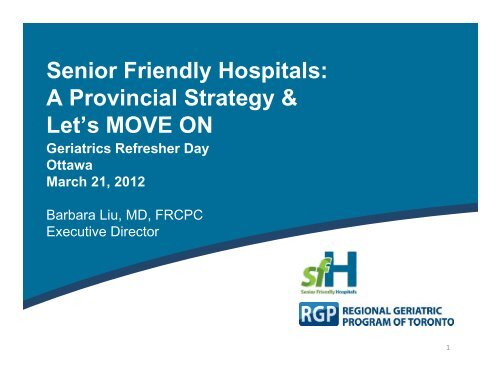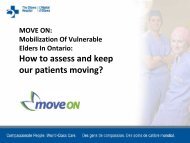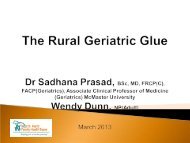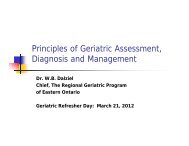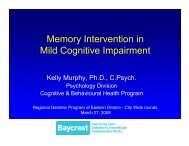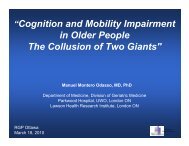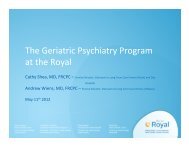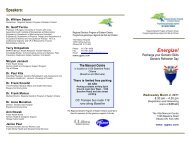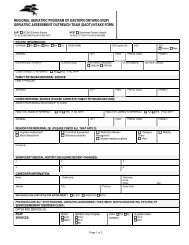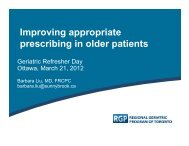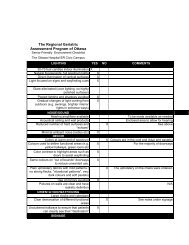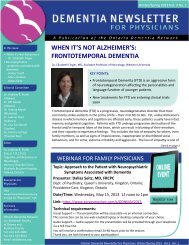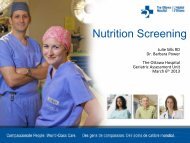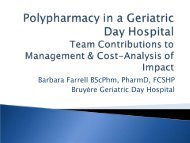Senior Friendly Strategy in Ontario - Let's MOVE ON - Regional ...
Senior Friendly Strategy in Ontario - Let's MOVE ON - Regional ...
Senior Friendly Strategy in Ontario - Let's MOVE ON - Regional ...
You also want an ePaper? Increase the reach of your titles
YUMPU automatically turns print PDFs into web optimized ePapers that Google loves.
<strong>Senior</strong> <strong>Friendly</strong> Hospitals:<br />
A Prov<strong>in</strong>cial <strong>Strategy</strong> &<br />
Let’s <strong>MOVE</strong> <strong>ON</strong><br />
Geriatrics Refresher Day<br />
Ottawa<br />
March 21, 2012<br />
Barbara Liu, MD, FRCPC<br />
Executive Director<br />
1
Outl<strong>in</strong>e<br />
• The challenge for<br />
hospitals<br />
• A SFH framework<br />
• The prov<strong>in</strong>cial senior friendly hospital<br />
strategy<br />
• Results to date<br />
• Next steps<br />
• Alignment<br />
2
RGP <strong>Senior</strong> <strong>Friendly</strong><br />
Hospital Framework<br />
Processes of<br />
Care<br />
Emotional &<br />
Behavioural<br />
Environment<br />
Ethics <strong>in</strong><br />
Cl<strong>in</strong>ical Care &<br />
Research<br />
Organizational<br />
Support<br />
Physical<br />
Environment<br />
What we do How Who Why Where<br />
3
<strong>Senior</strong> <strong>Friendly</strong> Hospital Prov<strong>in</strong>cial <strong>Strategy</strong><br />
Objective<br />
•Identify current<br />
state<br />
Plan<br />
•Hospital self‐<br />
Assessment<br />
•LHIN‐level roll‐up<br />
• Prov<strong>in</strong>cial roll‐up<br />
Objective<br />
• Close the gap<br />
Plan<br />
•Implement hospital<br />
improvement plans<br />
•Develop key enablers<br />
Objective<br />
• Monitor and susta<strong>in</strong> hospital<br />
and system improvements<br />
Future State<br />
• Prevent functional decl<strong>in</strong>e<br />
• Improve patient experience<br />
• Enable hospital staff<br />
• Improve equity<br />
4
<strong>Senior</strong> <strong>Friendly</strong> Hospital Care <strong>in</strong> the TC LHIN<br />
5
<strong>Senior</strong> <strong>Friendly</strong> Hospital Care <strong>in</strong> <strong>Ontario</strong><br />
•<strong>Senior</strong> <strong>Friendly</strong> Hospital self‐assessments completed by<br />
155 hospitals <strong>in</strong> <strong>Ontario</strong><br />
•6 RGPs of <strong>Ontario</strong> worked with 13 LHINs to generate<br />
regional SFH summary reports<br />
•Coord<strong>in</strong>ation by<br />
TCLHIN and RGP of<br />
Toronto<br />
6
Prov<strong>in</strong>cial Summary Report<br />
•Describes exist<strong>in</strong>g<br />
state of SFH care <strong>in</strong><br />
<strong>Ontario</strong><br />
•Identifies promis<strong>in</strong>g<br />
practices<br />
•Recommends priority<br />
areas for action<br />
7
Organizational Support<br />
• Hospital Leadership<br />
– 56% of hospitals designated a senior executive to lead SFH<br />
– 39% had SFH goals <strong>in</strong> strategic plan<br />
– 30% had explicit commitment at level of board of directors<br />
• Support<strong>in</strong>g Human Resources Development<br />
– 55% had geriatrics content <strong>in</strong> orientation or education for staff<br />
frailty focused education to all staff<br />
develop<strong>in</strong>g geriatrics champions<br />
HR policies that encourage skills development <strong>in</strong> geriatrics<br />
• Service Plann<strong>in</strong>g Structures<br />
solicit <strong>in</strong>put from community and health system partners<br />
8
Processes of Care<br />
Cl<strong>in</strong>ical Protocols/Monitor<strong>in</strong>g<br />
• most common – falls, pressure ulcers,<br />
restra<strong>in</strong>t use, pa<strong>in</strong> management<br />
• least common – management of behaviours,<br />
sleep, functional decl<strong>in</strong>e, hydration/nutrition<br />
• functional decl<strong>in</strong>e an emerg<strong>in</strong>g priority<br />
Interprofessional Practice <strong>in</strong> the Hospital<br />
geriatric assessment teams, leverag<strong>in</strong>g volunteers<br />
Inter-organizational Collaboration for Transitions <strong>in</strong> Care<br />
post D/C follow-up care<br />
partnerships for transitional care<br />
9
Emotional and Behavioural Environment<br />
Patient‐Centred Care Designed with <strong>Senior</strong>s <strong>in</strong> M<strong>in</strong>d<br />
•28% of hospitals ‐ age‐specific measures <strong>in</strong> satisfaction or<br />
quality improvement <strong>in</strong>itiatives<br />
Staff for way‐f<strong>in</strong>d<strong>in</strong>g, personal menu assistance<br />
Support<strong>in</strong>g Communication and Patient<br />
Involvement <strong>in</strong> Care<br />
hear<strong>in</strong>g amplifiers, translation services<br />
team rounds at the bedside<br />
Early goal sett<strong>in</strong>g discussions<br />
discharge plann<strong>in</strong>g <strong>in</strong>formation packages<br />
10
Ethics <strong>in</strong> Cl<strong>in</strong>ical Care and Research<br />
Access to a Cl<strong>in</strong>ical Ethicist for Complex Situations<br />
• 83% of hospitals have access to a bioethicist<br />
regular learn<strong>in</strong>g opportunities (case studies, lunch and learns)<br />
Procedures for Capacity and Consent Issues<br />
<strong>in</strong>ternal processes <strong>in</strong>volv<strong>in</strong>g appropriate cl<strong>in</strong>ical staff<br />
consultation with external bodies<br />
Procedures for Advance Directives<br />
•78% of hospitals have formal<br />
policies/procedures, but many are limited<br />
<strong>in</strong> scope to resuscitation orders<br />
resources provided to patients, families<br />
and care team to guide advance care<br />
directives<br />
11
Physical Environment<br />
•34% of hospitals have performed SFH audits<br />
to prioritize improvements to physical<br />
spaces<br />
•overall reliance on AODA and build<strong>in</strong>g code<br />
standards <strong>in</strong> physical plann<strong>in</strong>g<br />
<strong>in</strong>volvement of cl<strong>in</strong>ical staff and older<br />
adults <strong>in</strong> physical environment plann<strong>in</strong>g to<br />
<strong>in</strong>form design team<br />
12
Prov<strong>in</strong>cial SFH Action Priorities<br />
• Functional Decl<strong>in</strong>e<br />
– Implement <strong>in</strong>terprofessional early mobilization protocols<br />
across hospital departments to optimize physical function<br />
• Delirium<br />
– Implement <strong>in</strong>terprofessional delirium screen<strong>in</strong>g,<br />
prevention, and management protocols across hospital<br />
departments to optimize cognitive function<br />
• Transitions In Care<br />
– Implement practices and develop<strong>in</strong>g partnerships that<br />
promote <strong>in</strong>terorganizational collaboration with community<br />
and post-acute services<br />
13
<strong>Senior</strong> <strong>Friendly</strong> Hospital Prov<strong>in</strong>cial <strong>Strategy</strong><br />
Objective<br />
•Identify current<br />
state<br />
Plan<br />
•Hospital self‐<br />
Assessment<br />
•LHIN‐level roll‐up<br />
• Prov<strong>in</strong>cial roll‐up<br />
Objective<br />
• Close the gap<br />
Plan<br />
•Implement hospital<br />
improvement plans<br />
•Develop key enablers<br />
Objective<br />
• Monitor and susta<strong>in</strong> hospital<br />
and system improvements<br />
Future State<br />
• Prevent functional decl<strong>in</strong>e<br />
• Improve patient experience<br />
• Enable hospital staff<br />
• Improve equity<br />
<br />
15
Toolkit Work<strong>in</strong>g Group<br />
• Dr. Barbara Liu (Co‐Chair), RGP Toronto<br />
• Dr. Gary Naglie (Co‐Chair), Baycrest Centre<br />
• Ken Wong, RGP Toronto<br />
• Dr. John Puxty, RGP SE <strong>ON</strong><br />
• David Jewell, RGP Central <strong>ON</strong><br />
• Anne Stephens, TC CCAC<br />
• Sharlene Kuzik, NW LHIN<br />
• L<strong>in</strong>ette Perry, Stevenson Memorial Hospital<br />
• Maria Boyes, Cambridge Memorial Hospital<br />
• Susan Franchi, St. Joseph’s Care Group<br />
• Karyn Popovich, North York General Hospital<br />
• Dr. Monidipa Dasgupta, St Joseph’s Health Care<br />
(London)<br />
• Bruce Viella, NE LHIN<br />
• Susan Bisaillon, Trillium Health Centre<br />
• Emily Christoffersen, Hamilton Health Sciences<br />
16
Toolkit Development Process<br />
• Literature review<br />
• Tools shortlisted<br />
• Vot<strong>in</strong>g on<br />
– Feasibility<br />
– Interprofessional usability<br />
– Need for additional resources/tra<strong>in</strong><strong>in</strong>g<br />
– contributes to enhanced care<br />
• 499 responses on 34 tools from 25 people<br />
• Structure<br />
– Description, def<strong>in</strong>ition, rationale<br />
– Recommendations from prov<strong>in</strong>cial summary report<br />
– Screen<strong>in</strong>g and detection – tools<br />
– Prevention and management – guidel<strong>in</strong>es, review articles,<br />
other<br />
– Knowledge exchange portal<br />
17
SFH Toolkit Home Page<br />
•• Located Located with<strong>in</strong> with<strong>in</strong> “<strong>Senior</strong> “<strong>Senior</strong> <strong>Friendly</strong> <strong>Friendly</strong><br />
Hospitals” Hospitals” tab tab –access –access to to other other<br />
tabs tabs provides provides a a handy handy l<strong>in</strong>k l<strong>in</strong>k to to<br />
related related RGP RGP resources resources<br />
•• direct direct navigation navigation also also via via<br />
www.seniorfriendlyhospitals.ca<br />
www.seniorfriendlyhospitals.ca
Tools<br />
Click<strong>in</strong>g on the tool l<strong>in</strong>k opens a<br />
summary page conta<strong>in</strong><strong>in</strong>g practical<br />
<strong>in</strong>formation on use of the tool,<br />
<strong>in</strong>structions and sourc<strong>in</strong>g<br />
<strong>in</strong>formation
Evidence –based content<br />
Where Where applicable, applicable, the the<br />
evidence evidence from from the the<br />
literature literature is is organized organized by by<br />
SFH SFH Framework Framework doma<strong>in</strong> doma<strong>in</strong><br />
tabs, tabs, re<strong>in</strong>forc<strong>in</strong>g re<strong>in</strong>forc<strong>in</strong>g<br />
organization‐wide<br />
organization‐wide<br />
approaches approaches<br />
SCROLL
Prov<strong>in</strong>cial SFH Action Priorities<br />
• Functional Decl<strong>in</strong>e<br />
– Implement <strong>in</strong>terprofessional early mobilization protocols<br />
across hospital departments to optimize physical function<br />
• Delirium<br />
– Implement <strong>in</strong>terprofessional delirium screen<strong>in</strong>g,<br />
prevention, and management protocols across hospital<br />
departments to optimize cognitive function<br />
• Transitions In Care<br />
– Implement practices and develop<strong>in</strong>g partnerships<br />
that promote <strong>in</strong>terorganizational collaboration<br />
with community and post-acute services<br />
21
Mobilization of Vulnerable Elders<br />
Co PI: B Liu, S Straus<br />
Sunnybrook HSC<br />
St. Michael’s Hospital<br />
Baycrest<br />
Mt. S<strong>in</strong>ai Hospital<br />
22
Knowledge-to-Action Cycle<br />
Select, Tailor,<br />
Implement<br />
Interventions<br />
Assess<br />
Barriers to<br />
Knowledge Use<br />
Adapt<br />
Knowledge<br />
to Local Context<br />
Monitor<br />
Knowledge<br />
Use<br />
KNOWLEDGE CREATI<strong>ON</strong><br />
Knowledge<br />
Inquiry<br />
Synthesis<br />
Products/<br />
Tools<br />
Identify Problem<br />
Tailor<strong>in</strong>g Knowledge<br />
Evaluate<br />
Outcomes<br />
Susta<strong>in</strong><br />
Knowledge<br />
Use<br />
Identify, Review,<br />
Select Knowledge<br />
Graham et al., 2006<br />
23
Complications of Immobility<br />
Respiratory System<br />
• Decreased lung volume<br />
• Pool<strong>in</strong>g of mucous<br />
• Cilia less effective<br />
• Decreased oxygen<br />
saturation<br />
• Aspiration<br />
•Atelectasis<br />
Gastro<strong>in</strong>test<strong>in</strong>al System<br />
• Reflux<br />
• Loss of appetite<br />
• Decreased peristalsis<br />
• Constipation<br />
Musculoskeletal System<br />
• Weakness<br />
• Muscle atrophy<br />
• Loss of muscle strength by 3-5%<br />
• Calcium loss from bones<br />
• Increased risk of falls due to weakness<br />
Psychological<br />
• Anxiety<br />
• Depression<br />
• Sensory deprivation<br />
• Learned helplessness<br />
• Delirium<br />
Circulatory System<br />
• Loss of plasma volume<br />
• Loss of orthostatic<br />
compensation<br />
• Increased heart rate<br />
• Development of DVT<br />
Genitour<strong>in</strong>ary System<br />
• Incomplete bladder<br />
empty<strong>in</strong>g<br />
• Formation of calculi <strong>in</strong><br />
kidneys and <strong>in</strong>fection
“...rest <strong>in</strong> bed is anatomically, physiologically and<br />
psychologically unsound. Look at a patient ly<strong>in</strong>g long <strong>in</strong><br />
bed. What a pathetic picture he makes!<br />
The blood clott<strong>in</strong>g <strong>in</strong> his ve<strong>in</strong>s, the lime dra<strong>in</strong><strong>in</strong>g from his<br />
bones, the scybala stack<strong>in</strong>g up <strong>in</strong> his colon, the flesh<br />
rott<strong>in</strong>g from his seat, the ur<strong>in</strong>e leak<strong>in</strong>g from his<br />
distended bladder and the spirit evaporat<strong>in</strong>g from his<br />
soul.”
Selected RCT evidence for early<br />
mobilization<br />
Surgical<br />
Dx<br />
Many RCTs<br />
Pneumonia<br />
Stroke<br />
Cochrane<br />
Review<br />
(2009)<br />
LOS 5.8 vs. 6.9 days<br />
(Mundy Chest 2003;124:883‐889)<br />
Barthel Index at 3 months<br />
Earlier return to walk<strong>in</strong>g 3.5 vs. 7 days P=0.03<br />
(Cumm<strong>in</strong>g TB Stroke 2011; 42 :153)<br />
Discharge to home, NNT=16<br />
LOS by 1.08 days (‐1.93 to ‐0.22)
Ly<strong>in</strong>g<br />
‣ 83% of measured hospital stay spent <strong>in</strong> bed<br />
‣ Median time spent stand<strong>in</strong>g or walk<strong>in</strong>g<br />
= 43 m<strong>in</strong>utes or 3% of day<br />
Sitt<strong>in</strong>g<br />
Walk<strong>in</strong>g<br />
Brown, C et al JAGS 2009;57:1660<br />
27
Basel<strong>in</strong>e Data<br />
% <strong>in</strong> bed unit 1<br />
% <strong>in</strong> bed Unit 2
Processes of<br />
Care<br />
Processes of<br />
Care<br />
Organizational<br />
Support<br />
Physical<br />
Environment<br />
Ethics <strong>in</strong><br />
Cl<strong>in</strong>ical Care &<br />
Research<br />
Emotional &<br />
Behavioural<br />
Environment<br />
Brown, C et al J Hosp Med 2007;2:305<br />
29
Fishbone diagram
Knowledge-to-Action Cycle<br />
Select, Tailor,<br />
Implement<br />
Interventions<br />
Assess<br />
Barriers to<br />
Knowledge Use<br />
Adapt<br />
Knowledge<br />
to Local Context<br />
Monitor<br />
Knowledge<br />
Use<br />
KNOWLEDGE CREATI<strong>ON</strong><br />
Knowledge<br />
Inquiry<br />
Synthesis<br />
Products/<br />
Tools<br />
Identify Problem<br />
Tailor<strong>in</strong>g Knowledge<br />
Evaluate<br />
Outcomes<br />
Susta<strong>in</strong><br />
Knowledge<br />
Use<br />
Identify, Review,<br />
Select Knowledge<br />
Graham et al., 2006<br />
31
Goals of <strong>MOVE</strong> <strong>ON</strong><br />
• Mobility assessment with<strong>in</strong> 24 hours of the<br />
decision to admit and reassessment daily<br />
• At least three times a day, progressive,<br />
scaled mobilization<br />
32
Mobility<br />
Assessment<br />
Algorithm
Simplified Mobility Assessment Algorithm<br />
1. Can they respond to verbal stimuli?<br />
2. Can they roll side to side?<br />
3. Can they sit at edge of bed?<br />
4. Can they straighten one or both legs?<br />
5. Can they stand?<br />
6. Can they transfer to a chair?<br />
7. Can they walk a short distance?<br />
Mobility<br />
Level<br />
C<br />
B<br />
A
A Review of the ABC’s of Mobility<br />
35
• Daily assessment of mobility<br />
status<br />
• Mobilize three times daily<br />
• Incorporates <strong>in</strong>terprofessional<br />
teamwork and attitude<br />
awareness tra<strong>in</strong><strong>in</strong>g<br />
• Multipronged tailored education
First step is to dangle<br />
To Chair
Respiratory ICU<br />
Intermounta<strong>in</strong> Medical<br />
Center<br />
Salt Lake City, Utah<br />
38
<strong>Senior</strong> <strong>Friendly</strong> Hospital Prov<strong>in</strong>cial <strong>Strategy</strong><br />
Objective<br />
•Identify current<br />
state<br />
Plan<br />
•Hospital self‐<br />
Assessment<br />
•LHIN‐level roll‐up<br />
• Prov<strong>in</strong>cial roll‐up<br />
Objective<br />
• Close the gap<br />
Plan<br />
•Implement hospital<br />
improvement plans<br />
•Develop key enablers<br />
Objective<br />
• Monitor and susta<strong>in</strong> hospital<br />
and system improvements<br />
Future State<br />
• Prevent functional decl<strong>in</strong>e<br />
• Improve patient experience<br />
• Enable hospital staff<br />
• Improve equity<br />
<br />
39
Indicator Work<strong>in</strong>g Group<br />
• Dr. Barbara Liu (Co‐Chair), RGP Toronto<br />
• Rhonda Schwartz (Co‐Chair), Baycrest Centre<br />
• Ken Wong, RGP Toronto<br />
• Michelle Rey, Health Quality <strong>Ontario</strong><br />
• Rebecca Comrie, Health Quality <strong>Ontario</strong><br />
• Annette Marcuzzi, Central LHIN<br />
• Marilee Suter, Central East LHIN<br />
• Brian Putman, North Simcoe Muskoka LHIN<br />
• M<strong>in</strong>nie Ho, ICES<br />
• Dr. Carrie McA<strong>in</strong>ey, St. Josephs’ Healthcare Hamilton<br />
• Dr. John Puxty, RGP SE <strong>Ontario</strong><br />
• Dana Chlemitsky, University Health Network<br />
• Dr. Sharon Marr, RGP Central <strong>Ontario</strong><br />
• Kim Kohlberger, Halton Healthcare<br />
• Cather<strong>in</strong>e Cotton, St. Joseph's Health Centre<br />
• Kelly Milne, RGP Eastern <strong>Ontario</strong><br />
40
Indicators workplan/timel<strong>in</strong>e<br />
41
Patient &<br />
Care Team<br />
Alignment and<br />
momentum<br />
Susta<strong>in</strong><br />
42
The goals of the SFH (w<strong>in</strong>-w<strong>in</strong>-w<strong>in</strong>)<br />
• Patient / family<br />
– M<strong>in</strong>imize risk, improve safety<br />
– Maximize functional ability, improve outcomes<br />
– Improve care experience & satisfaction<br />
• Staff<br />
– Enabled to deliver best practice<br />
– Improve satisfaction<br />
• Hospital Strategic Alignment<br />
– Improve quality<br />
– Reduce adverse events & iatrogenic complications<br />
– Improve capacity for <strong>in</strong>dependent liv<strong>in</strong>g<br />
– Reduce ALC and readmissions<br />
43
National Round Table Meet<strong>in</strong>g on Quality and Safety<br />
Standards for Older People <strong>in</strong> Canadian Hospitals<br />
PI: B Liu, B. Parke, A Juby<br />
Quebec City, April 19, 2012<br />
Populations standards work<strong>in</strong>g group<br />
•Draft standards for system plann<strong>in</strong>g be<strong>in</strong>g piloted<br />
•Receptive to expand<strong>in</strong>g ROPs to <strong>in</strong>clude more senior<br />
relevant standards.<br />
44
Next steps<br />
• Knowledge exchange and networks<br />
– LHIN-wide networks and prov<strong>in</strong>cial<br />
collaborative<br />
• SFH is a cont<strong>in</strong>uous cycle<br />
– Expanded improvement plans<br />
– Enhanced toolkit resources<br />
• LHIN Integrated health services plans<br />
• MOHLTC <strong>Senior</strong>s <strong>Strategy</strong><br />
• HQO QIPs<br />
45
Processes of<br />
Care<br />
Ethics <strong>in</strong><br />
Cl<strong>in</strong>ical Care &<br />
Research<br />
Processes of<br />
Care<br />
Emotional &<br />
Behavioural<br />
Environment<br />
Organizational<br />
Support<br />
Organizational Support<br />
Ethics <strong>in</strong><br />
Cl<strong>in</strong>ical Care &<br />
Research<br />
Physical<br />
Environment<br />
Emotional &<br />
Behavioral<br />
Environ‐ment<br />
Physical<br />
Environ‐ment
“….a focus on geriatrics as the solution,<br />
not the problem.”<br />
J. Bennett, 2010<br />
48
TC LHIN<br />
• C Orridge<br />
• V Sakelaris<br />
• R Cook<br />
• T Mart<strong>in</strong>s<br />
• G Whitehead<br />
• S Smit<br />
TC LHIN SFH Taskforce<br />
• J Bennett (Co‐Chair)<br />
• B Liu (Co‐Chair)<br />
• M Codjoe<br />
• C Cotton<br />
• S VanDeVelde‐Coke<br />
• P Cripps‐McMart<strong>in</strong><br />
• L Dess<br />
• C Levy<br />
SFH Toolkit Work<strong>in</strong>g Group of <strong>Ontario</strong><br />
G Naglie, B Liu –co‐chairs, et al.<br />
SFH Indicator Work<strong>in</strong>g Group of <strong>Ontario</strong><br />
R Schwartz, B Liu –co‐chairs, et al.<br />
TC LHIN SFH <strong>in</strong>dicator Work<strong>in</strong>g Group<br />
• J Bennett (Co‐Chair)<br />
• B Liu (Co‐Chair)<br />
• C Cotton<br />
• L Dess<br />
• C Levy<br />
•C Millar<br />
•J O’Neill<br />
•M McCarthy<br />
•S VanDeVelde‐Coke<br />
•K Velji<br />
•J Walsh<br />
SFH LHIN Leads Work<strong>in</strong>g Group of<br />
A <strong>ON</strong> Anderson<br />
J Girard<br />
G Whitson Shea<br />
S Isaak<br />
S Stewart<br />
N Jaffer<br />
H Willis<br />
T Mart<strong>in</strong>s<br />
A Marcuzzi<br />
B Laundry<br />
C Russell<br />
C LeClerc<br />
P Istvan<br />
S Colwell<br />
M Auch<strong>in</strong>leck<br />
B Villella<br />
K Tasala<br />
www.rgp.toronto.on.ca<br />
www.seniorfriendlyhospitals.ca 49


